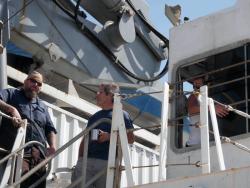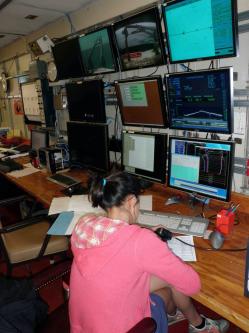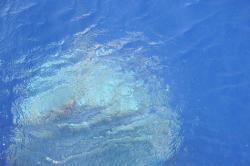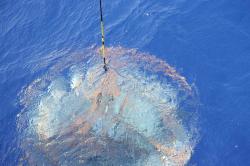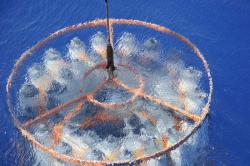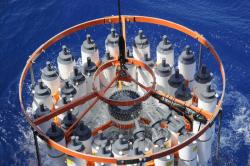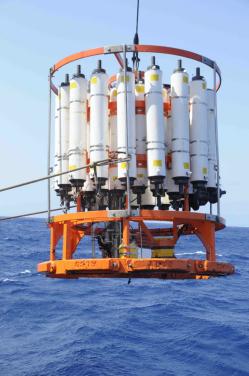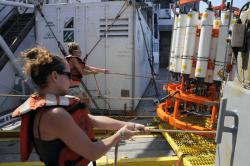Karen StamieszkinThe CTD rosette, or package, weighs 800 lbs in air, empty, and contains $150,000 of scientific instruments and Niskin bottles. The instruments on this package measure temperature, conductivity (translates into salinity), depth, fluorescence (translates into chlorophyll/phytoplankton density), altitude above the seafloor, and over-all particle density in the water column. There are replicate instruments on the rosette to make sure that the measurements are accurate. In short, this is about as hefty an instrument package as you will see lowered over the side of a research vessel like the R/V Melville. The process of putting the package over the side and lowering it to ten meters above the bottom of the ocean is an orchestration of four teams: the console team (one person), the tag line and A-frame team, or deck crew (four people), the winch team (one person) and the bridge (the person in control of the vessel’s position). The process is as follows: First, the package is mechanically wheeled to the edge of the ship, where it is untied from its platform. The winch and A-frame together raise the entire rosette into the air, while tension is kept by two people with “tag lines,” or lines used to control the movement of the package. Once the rosette is safely over the side of the ship and in the water, the two tag lines are slipped out and the winch is the only thing holding the rosette, by a cable that contains all the wiring necessary for the on-ship lab can communicate with the rosette. At this point, one can see data streaming live from the instruments in the rosette at the computer console. Refer to the website for the types of profiles that are seen as the package is lowered to the seafloor. The person sitting at the computers in the lab can see when the rosette is almost at the bottom of the ocean, using the signal from the altimeter. It is a tense moment, because this package of important instruments MUST NOT HIT BOTTOM! And, if the ship is rolling at the surface, the wire on the package is tensioning and then releasing, causing the rosette to move even all the way down at the seafloor. At this point, the person in the lab has control and asks the winch operator to bring the rosettes up to specific depths where we want to sample. When the rosette reaches these depths, a button is pushed on the computer screen, sending a signal all the way down to one Niskin bottle, causing it to close, thereby collecting water at specific depths. Once at the surface, the deck crew grabs hold of the package with ropes, and with the help of the winch and A-frame, set the rosette back on deck. While all this is happening, the person on the bridge, makes sure that the ship stays on station, and that the ship does not run over the wire holding onto the rosette. The ship has to rotate, on a point, around the wire. Much of this is done automatically with a GPS, and the ships thrusters (a sort of specialized propellers). The deepest station that will be sampled during this cruise is over six kilometers deep and is part of the Tonga Trench! Last updated: December 1, 2009 | |||||||||||||
Copyright ©2007 Woods Hole Oceanographic Institution, All Rights Reserved, Privacy Policy. | |||||||||||||
